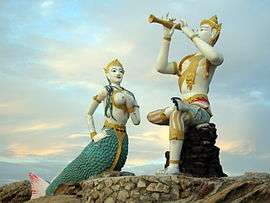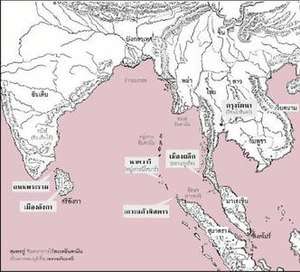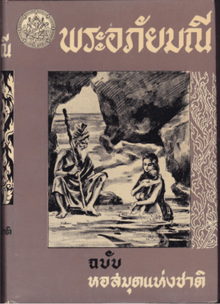Phra Aphai Mani
 Aphai Mani statue on Ko Samet | |
| Author | Sunthorn Phu |
|---|---|
| Original title | พระอภัยมณี |
| Country | Thailand |
| Language | Thai |
| Genre | Epic poem |
| Published | 1870 (finished 1844) |
| Media type | samut thai |
| Pages | 1422 (unbridged) |
Phra Aphai Mani (Thai: พระอภัยมณี) is a 48,700-line epic poem written by Thailand's national poet, Sunthorn Phu (Thai: สุนทรภู่), also known as "the Bard of Rattanakosin" (Thai: กวีเอกแห่งกรุงรัตนโกสินทร์). It is considered to be one of Thailand's national epics, and is, at 48,686 couplets, the single longest poem in the Thai language. Suthorn Phu started composing this epic fantasy from around 1822 and finished it in 1844. It is also part of Thai folklore and has been adapted into films and comics. The main protagonists are Prince Aphai Mani, a mermaid, and a female yak or ogress.
Although, Phra Aphai Mani contains many mythical creatures and supra-natural protagonists, it is different from other Thai epics in that it is an original imaginative work of one poet rather than a poetic tale based on a well-known folk story like Khun Chang Khun Phaen. Moreover, Phra Aphai Mani was composed during the period of western colonization of Southeast Asia. Parts of the story mention exploits of white Europeans, either as mercenaries or pirates. Some Thai literary critics believe that Suthorn Phu composed Phra Aphai Mani as an anti-colonization story, disguised as a versified tale of fantasy adventures.[1]
Synopsis

Phra Aphai Mani (พระอภัยมณี) and his brother, Sisuwan (ศรีสุวรรณ), are Thai princes. Their father sent them away to study with the hope that they would gain knowledge to help them rule the country. Sisuwan learned to sword fight and Phra Aphai Mani learned to play a magical flute that could put people to sleep or kill them. When they returned home, their father was angered by what they had learned and drove them away.
One day while Aphai's companions were lulled to sleep by the sound of his pipe, a female ogress named Nang Phisuea Samut (นางผีเสื้อสมุทร), came and took Aphai away to her cave. She disguised herself as a beautiful maiden and Aphai fell in love with her. They lived together until she bore a son, Sinsamut (สินสมุทร). When Aphai found out that his wife was really an ogress, he fled with his son. He was assisted by a family of mermaids, a father, mother, and daughter. The father and mother were caught and eaten by the ogress. The mermaid daughter took Aphai and Sinsamut to Ko Kaeo Phitsadan (Wonder Island) where a hermit saved them from the ogress. Aphai married the mermaid daughter and they had a son, named Sutsakhon (สุดสาคร).
One day, a ship, carrying King Silarat (ท้าวสิลราช) and Princess Suwanmali of Phaluek (สุวรรณมาลี), passed Wonder Island. The princess was engaged to marry the European Prince Usaren (อุศเรน) of Langka (heavily based on British Ceylon). Aphai and Sinsamut asked to join the ship, but the ogress saw them and became very angry. Nang Phisuea Samut attacked them and killed King Silarat. Aphai escaped to the shore, where he played his magic flute and killed the ogress. Afterwards, he met Prince Usaren, who was looking for his fiancée.
Meanwhile, Sinsamut swam with the princess to an island and met Sisuwan and his daughter, Arun Ratsami (อรุณรัศมี). Together, they went in search of Phra Aphai. When they found Phra Aphai and Usaren, Princess Suwwanmali refused to leave with Usaren. The two parties fought and Prince Usaren fled to his homeland of Lanka.
Phra Aphai continued on to Phaluek where the queen asked him to rule the country. Angry at Phra Aphai for daring to give her up to Usaren, Princess Suwwanmali fled to become a nun. But later with the trick of a maid, Nang Wali (นางวาลี), Suwanmali abandoned the nunhood to marry Phra Aphai. She bore him twin daughters named Soisuwan and Chanthasuda.
Years later, Usaren and his father returned to attack Phaluek. The father was killed and Usaren died heart-broken. The throne of Langka fell to his sister, Nang Laweng. The very beautiful blonde-haired Laweng decided to take revenge. She declared to all the princes in neighboring that whoever could kill King Aphai would have her and her kingdom. Nine armies moved to surround Phaluek. Aphai followed Laweng and eventually won her love, but the war continued until a hermit came and helped to stop the war between them.
Composition, innovations, and (possible) influences

The epic tale of Phra Aphai Mani is a truly massive work of poetry in klon suphap (Thai: กลอนสุภาพ). The unabridged version published by the National Library is 48,686-Bāt (2-line couplet) long, totaling over 600,000 words, and spanning 132 samut Thai books - by far the single longest poem in the Thai language,[2] and is the world's second longest epic poem written by a single poet (the longest being the Iranian epic Shahnameh). Sunthorn Phu, however, originally intended to end the story at the point where Phra Aphai abdicates the throne and retires into the wood. This leaves his original vision of the work at 25,098 lines of poetry - spanning 64 samut thai books. But his literary patron wanted him to continue composing, which he did for many years until it reached final length. Today, the abridged version - i.e. his original 64 samut-thai volumes, totaling 25,098 couplets of poetry - is regarded as the authoritative text of the epic. It took Sunthorn Phu more than 20 years to compose (from around 1822 or 1823 to 1844).
Phra Aphai Mani is Sunthorn Phu's Chef-d'œuvre. It breaks the tradition of earlier Thai poetic novels or nithan kham-klon (Thai: นิทานคำกลอน) by including western mythical creatures, such as mermaid, and contemporary inventions, such as steam-powered ships (Thai: สำเภายนต์) which only started to appear in Europe. Sunthorn Phu also writes about a mechanical music player at the time when a gramophone or a self-playing piano was yet to be invented. This made Phra Aphai Mani surprisingly futuristic for the time. Also, unlike other classical Thai epic poems, Phra Aphai Mani depicts various exploits of white mercenaries and pirates which reflects the ongoing colonization of Southeast Asia in the early 19th Century. Phra Aphai himself is said to have learned "to speak Farang (European), Chinese and Cham languages." Moreover, the locations of cities and islands in Phra Aphai Mani are not imagined but actually correspond to real geographical locations in the Andaman Sea as well as east of the Indian Ocean. Sunthorn Phu could also give an accurate knowledge of modern sea voyage in that part of the world. This suggests that the Thai Bard (Sunthorn Phu) must have acquired these knowledge from foreign seafarers first-handedly. The multi-cultural and the half-mythical, half-realistic setting of Phra Aphai Mani - combined with Sunthorn Phu's poetical brilliance - makes Phra Aphai Mani a unique literary masterpiece.
Phra Aphai Mani as the Siamese Odyssey
Western colonialism was spreading into Southeast Asia at the time when Sunthorn Phu was composing Phra Aphai Mani. Many Thai literary critics have suggested that Sunthorn Phu may have intended his epic masterpiece to be an anti-colonialism story, disguised as a versified tale of fantasy adventures.[3] Sujit Wongthes, for example, proposes that Sunthorn Phu models Nang Laweng, Phra Aphai's beautiful blonde-haired female nemesis who later becomes his lover, after Queen Victoria of England.[4] He also cites the fact that Sunthorn Phu portrays an English captain of a huge privateer (or a pirate ship) as a villainous character to support his claim.[5] In a literary sense, however, Phra Aphai Mani could perhaps be inspired by great Greek epic and Persian literature, notably the Iliad, the Odyssey, the Argonauts, and Thousand and One Nights. The structure of Phra Aphai Mani conforms well to the Monomyth structure, shared by other great epic stories. Indeed, it is possible that Sunthorn Phu may have learned these epic stories from European missionaries, Catholic priests or learned individuals who travelled to Siam during the early 19th century. Phra Aphai, the main protagonist, resembles Orpheus - the famed musician of the Argonauts - rather than a warrior like Achilles. However, Phra Aphai's odyssean journey conjures a similarity with the King of Ithaca. Pii Sue Samut ("the Sea Butterfly"), a love-struck female titan who kidnaps the hero, vaguely reminds us of the nymph Calypso. Also, much like Odysseus, Phra Aphai's long voyage enables him to speak many languages and to learn the minds and customs of many foreign races. Phra Aphai's name (Thai: อภัย: "forgive") is pronounced quite similar to how "Orpheus" (Greek: Ὀρφεύς) is pronounced in Greek. In addition, Nang Laweng's bewitching beauty, so captivating it drives nations to war, seems to match the reputation of fair-haired Helen of Troy. Others have suggested that Nang Laweng may have been inspired by a story of a Christian princess, told in Persia's Thousand and One Nights, who falls in love with a muslim king.
In composing Phra Aphai Mani, Sunthorn Phu demonstrates a grand poetic ambition. He became the first Thai writer to draw inspirations from vast western literary sources and produced an epic literature based, loosely, on the amalgamation of those myths and legends. Thus, rather than writing with a political motive, Sunthorn Phu might simply want to challenge the best poets and literature of the west.
Phra Aphai Mani in modern popular culture
There are a few Thai films based on this popular legend, including The Adventure of Sudsakorn and Legend of Sudsakorn.
There is also a Thai comic series with the name Apaimanee Saga.
On some locations in Thailand, such as Ko Samet island and Cha-am, there are statues related to the Phra Aphai Mani story.[6][7]
A ballad with some kind of a similar story exists in Sweden: Herr_Mannelig.
See also
References
- ↑ "พระอภัยมณีวรรณคดีการเมือง ต่อต้านการล่าเมืองขึ้น" (PDF). สุจิตต์ วงษ์เทศ.
- ↑ "พระอภัยมณี, คำนำเมื่อพิมพ์ครั้งแรก". หอสมุดวชิรญาณ.
- ↑ "พระอภัยมณีวรรณคดีการเมือง ต่อต้านการล่าเมืองขึ้น" (PDF). สุจิตต์ วงษ์เทศ.
- ↑ ibid.
- ↑ ibid.
- ↑ Ko Samet Aphai Mani and the mermaid statue
- ↑ Water Figure Park, Puek Tian, Cha-am - Phra Apai Mani
External links

| Wikivoyage has a travel guide for Ko_Samet. |